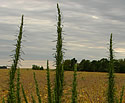Artemisia biennis (Biennial Wormwood)
| Also known as: | |
|---|---|
| Genus: | Artemisia |
| Family: | Asteraceae (Aster) |
| Life cycle: | annual, biennial |
| Origin: | Northwest US |
| Status: |
|
| Habitat: | sun; disturbed soil; waste areas, agricultural fields, roadsides, ditches, stream banks |
| Bloom season: | August - October |
| Plant height: | 1 to 10 feet |
| Wetland Indicator Status: | GP: FACU MW: FACW NCNE: FACW |
| MN county distribution (click map to enlarge): |  |
| National distribution (click map to enlarge): |  |
Pick an image for a larger view. See the glossary for icon descriptions.
Detailed Information
Flower: 

![[photo of flowers]](/udata/r9ndp23q/pd/artemisia-biennis-7879348-5-t.jpg) Flowers are numerous, yellow to green and globe like, 1/8 inch across in densely packed, short columnar clusters in the leaf axils, forming leafy, compound spikes on the upper stems and branches, several feet long on large specimens.
Flowers are numerous, yellow to green and globe like, 1/8 inch across in densely packed, short columnar clusters in the leaf axils, forming leafy, compound spikes on the upper stems and branches, several feet long on large specimens.
Leaves and stems: 


![[photo of leaves]](/udata/r9ndp23q/pd/artemisia-biennis-098304-1-t.jpg) Leaves are alternate, 1-3 inches long, deeply divided into long, narrow lobes with coarsely toothed edges. Lower leaves can be double divided. Leaves and stems are hairless throughout. Stems can be simple or much branched at the base. Plants typically have a narrow, spire-like profile.
Leaves are alternate, 1-3 inches long, deeply divided into long, narrow lobes with coarsely toothed edges. Lower leaves can be double divided. Leaves and stems are hairless throughout. Stems can be simple or much branched at the base. Plants typically have a narrow, spire-like profile.
Notes:
Biennial wormwood is a North American native species whose range has expanded dramatically since European settlement. Originating in the Pacific NW, it is now found across Canada to Nova Scotia and in the US, from California to New England. Modern agriculture practice has exerted selection pressure for the annual rather than biennial biotype and it can respond quickly to disturbance. It flourishes along disturbed road margins, drainage ditches and has become a serious weed of soybeans and dry beans in the Dakotas and Minnesota. Unlike other Artemisia species, A. biennis has little or no odor when leaves and stems are crushed.
Native Plant Nurseries, Restoration and Landscaping Services ↓
More photos
Photos courtesy Peter M. Dziuk taken in Garrison, ND, and in Wilkin and Traverse counties in MN.
Comments
Have you seen this plant in Minnesota, or have any other comments about it?
on: 2013-09-26 17:07:35
We have one of these growing in our garden in Duluth. I presume a seed either blew in or a bird brought it. We will be digging it up.
on: 2023-06-02 21:34:58
This plant occasionally appears in my gardens where it is an annual. The plants vary in height from a few inches to almost two feet.







 Biennial Wormwood plant
Biennial Wormwood plant emerging plant
emerging plant more plants
more plants more flowers
more flowers agricultural infestation
agricultural infestation